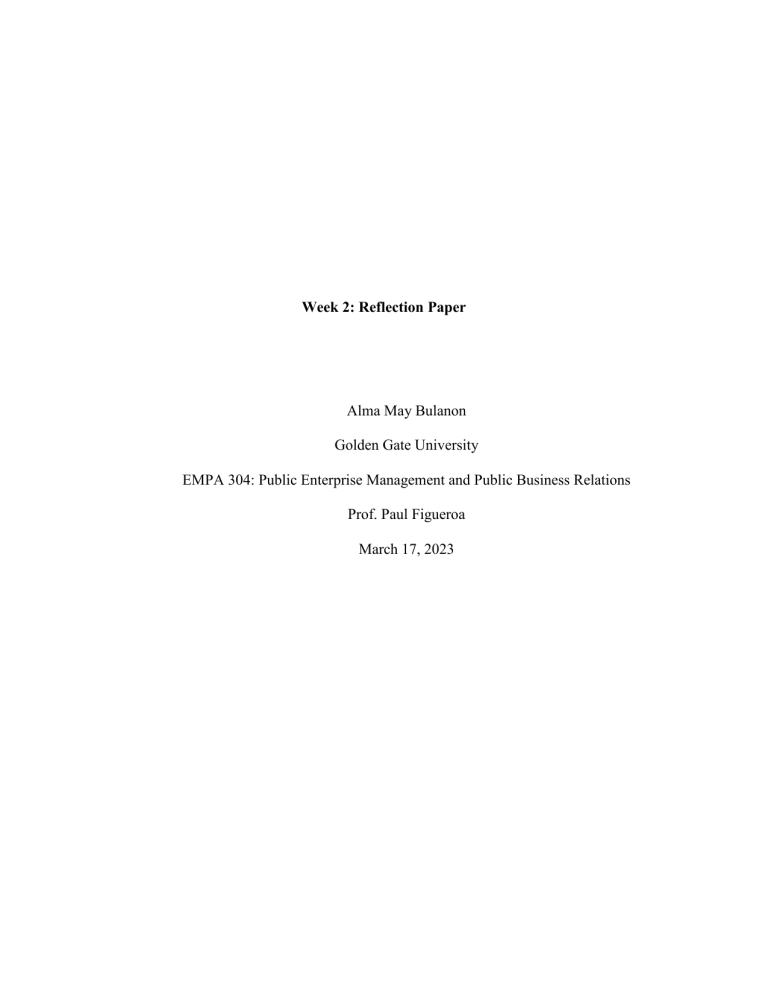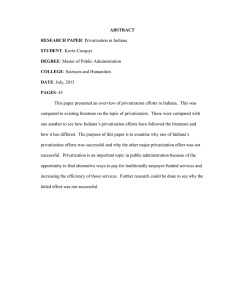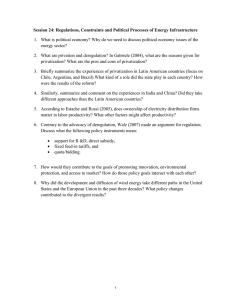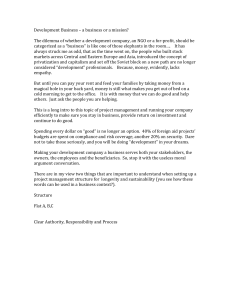
Week 2: Reflection Paper Alma May Bulanon Golden Gate University EMPA 304: Public Enterprise Management and Public Business Relations Prof. Paul Figueroa March 17, 2023 Privatization refers to the transfer of ownership of assets or services that were previously under government control to private individuals or organizations. This process can bring about both advantages and disadvantages to individuals in the society. We cannot deny the fact that we can all benefit from it, but at the same time, it could have a negative impact on us. We can view this as a learning experience and an opportunity to connect with the government system. Sometimes, when we are not affected by a certain situation, we tend to become detached from society. This paper is to provide reflections and insights that encourage everyone to share their thoughts, experiences, and learnings based on their acquired knowledge and other opportunities regarding the impact of privatization in the society, including both positive and negative aspects. One of the most common ways to achieve privatization is through selling governmentowned company stocks, which reduces the government's ownership and control. This process is often considered when a public sector entity is not performing well due to a lack of discipline. Privatizing such entities can lead to more discipline, better maintenance, and increased efficiency, resulting in higher profits and productivity. The concept of privatizing firms was introduced by Britain's Thatcher government in the early 1980s and has been widely accepted as a reliable tool for financial governance by more than 100 economies worldwide. It plays a vital role in facilitating market participation and allocating resources to respective nations. Privatization is important for any economy as it encourages healthy competition among private businesses, leading to fair pricing of goods and services. When a particular sector is privatized, it also creates job opportunities as more businesses enter the industry. Involving the private sector can improve the quality of goods and services (Vaidya, 2023) . Privatizing a sector can lead to positive outcomes and improving the quality of products and services. Therefore, it is essential to evaluate the potential pros and cons of privatization in each specific case. Privatizing government functions can bring about efficiency, cost savings, and innovation, it can also lead to accountability issues, declining service quality, job losses, and inequality. According to Gonzalez, “Privatizing to save money and time. Various government - from small towns all the way to up to federal agencies–have been sending public services to private sector since 1980s. The trend stems from the common belief that private companies save or make money by doing jobs faster and cheaper, or managing a public asset more efficiently (Gonzalez, 2016)”. Private companies can deliver services faster and more efficiently due to market competition and the need to meet customer demands in order to remain competitive. Additionally, private companies are often more agile and better equipped to adapt to changing circumstances than government agencies. According to Gonzales' book, "The effects of inefficient outsourcing deals are really about risk. You’re taking the risk of the unknown and dumping that on your supplier. You're outsourcing a problem to a company that has limited control over the root cause of the problem," says Adam Strichman. The only way for a public-private partnership to work is to drive transformation from within legacy systems (Gonzalez, 2016).Inefficient outsourcing can have a number of negative effects, particularly when it comes to the management of risk. When outsourcing arrangements are not well-structured or well-managed, it can lead to a range of problems that can put the organization at risk. For example, poorly negotiated contracts may not provide sufficient protection for the organization in the event of disputes or disagreements with the outsourcing partner. A successful outsourcing agreement, it is important to conduct a comprehensive costbenefit evaluation to determine whether a third-party can provide services more efficiently and cost-effectively compared to government employees (Gonzalez, 2016). It means that it is necessary to evaluate whether outsourcing services to a third-party would be a more efficient and costeffective option than using public employees to provide the same services. In conducting a thorough cost-benefit analysis, the organization can assess the advantages and disadvantages of outsourcing services to a third-party, and determine whether outsourcing is a viable option that would bring about improvements in service delivery while reducing costs. For instance in the type of privatization is the competitive contract bidding. The competitive bidding process involves defining the requirements and specifications, compiling a list of potential bidders, and selecting a provider based on pricing. The provider who submits the lowest responsive bid by the submission deadline is awarded the contract (Hewa,W.). Privatization can be a way to reduce risks, improve transparency, quality control, and compliance, and achieve cost-savings for organizations. By undergoing the bidding process, organizations can obtain better value for their money, reduce risks, and ensure transparency and fairness in the procurement process. This is particularly important when compliance with laws and regulations is required. In conclusion, privatization can have positive and negative effects on society, such as increased efficiency, cost savings, and job creation, but also accountability issues, declining service quality, and inequality. Before outsourcing services or privatizing firms, a comprehensive cost-benefit evaluation should be conducted to determine efficiency and cost-effectiveness. Competitive contract bidding can reduce risks and achieve cost-savings while ensuring transparency and fairness in the procurement process. It is important to carefully evaluate the implications of privatization in each specific case. The author of this article supports privatization and argues that it can be successful in improving firm performance and welfare in infrastructure sectors when accompanied by proper policy and regulatory frameworks. The author recommends that instead of abandoning or reversing privatization, efforts should be made to tailor it to local conditions, promote competition and regulatory frameworks, enforce transparency, and ensure access to affordable essential services for the poor (Nellis, 2004). Mechanisms should be put in place to ensure that essential services remain affordable and accessible for low-income individuals and families. By taking these measures, privatization can be carried out in a way that benefits society as a whole. It is also important to recognize that privatization is not a one-size-fits-all solution and that each case should be evaluated carefully to determine the most effective strategy that considers the needs of all stakeholders. References: Gonzalez, J. et al: 2016: Privatization in Practice: Reports on Trends, Cases and Debates in Public Service by Business and Nonprofits Nellis, J.et al. 2004: An Assessment of Privatization: https://www.jstor.org/stable/3986494 Hewa, W. et al.: Privatization Is More Contracting Out: https://onlinepubs.trb.org/Onlinepubs/trr/1988/1156/1156-009.pdf Vaidya, D. 2023: Privatization : https://www.wallstreetmojo.com/privatization/




